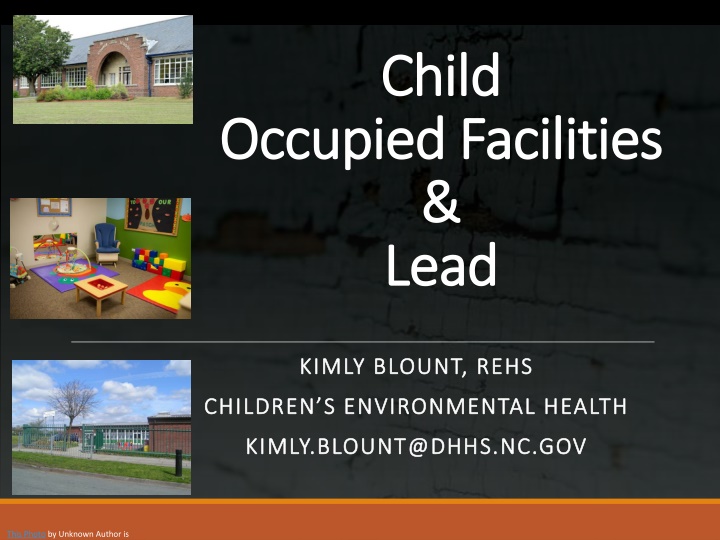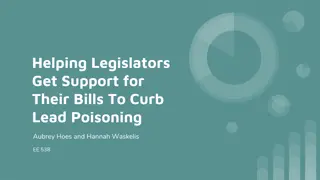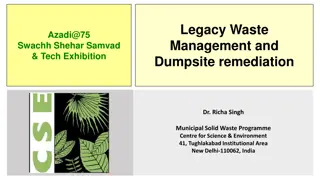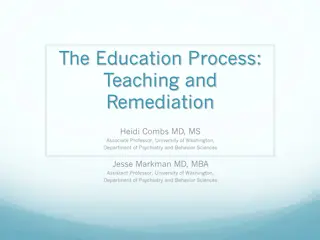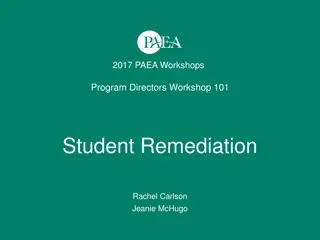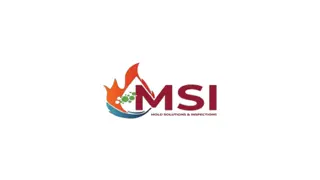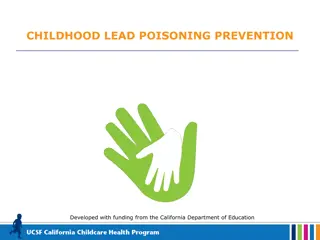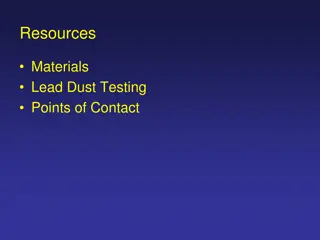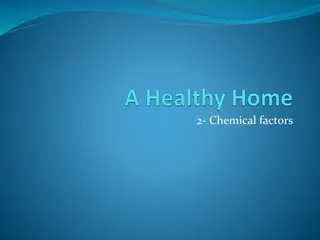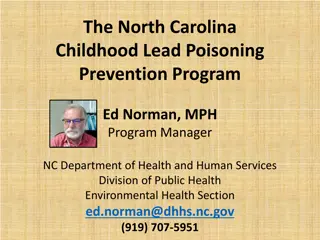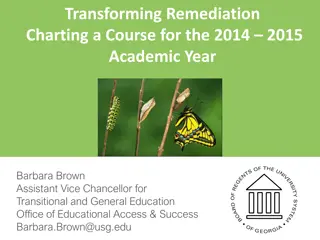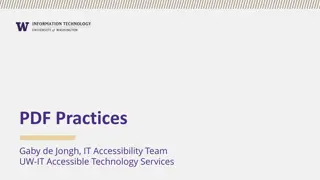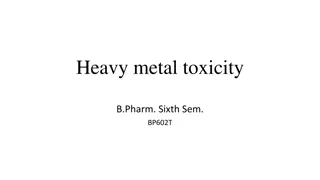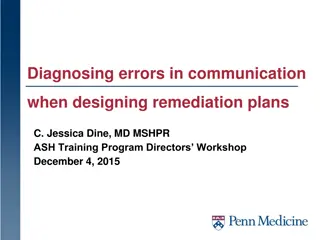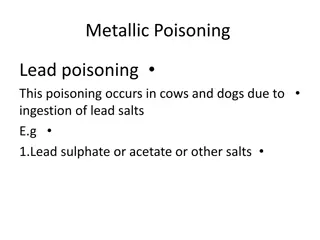Lead Poisoning Investigation and Remediation in Child-Occupied Facilities
Explore the protocols and requirements for lead investigations, remediation efforts, routine sanitation inspections, and monitoring in child care centers and schools to ensure the safety of children from lead hazards. Learn about lead poisoning thresholds, hazard identification, XRF testing, and more in this comprehensive guide.
Uploaded on Sep 10, 2024 | 3 Views
Download Presentation

Please find below an Image/Link to download the presentation.
The content on the website is provided AS IS for your information and personal use only. It may not be sold, licensed, or shared on other websites without obtaining consent from the author.If you encounter any issues during the download, it is possible that the publisher has removed the file from their server.
You are allowed to download the files provided on this website for personal or commercial use, subject to the condition that they are used lawfully. All files are the property of their respective owners.
The content on the website is provided AS IS for your information and personal use only. It may not be sold, licensed, or shared on other websites without obtaining consent from the author.
E N D
Presentation Transcript
Child Child Occupied Facilities Occupied Facilities & & Lead Lead KIMLY BLOUNT, REHS KIMLY BLOUNT, REHS CHILDREN S ENVIRONMENTAL HEALTH CHILDREN S ENVIRONMENTAL HEALTH KIMLY.BLOUNT@DHHS.NC.GOV KIMLY.BLOUNT@DHHS.NC.GOV This Photo by Unknown Author is licensed under CC BY
Child Occupied Facilities Child Care Centers Child Care Homes Schools Pre-K Programs
When is a Lead Investigation When is a Lead Investigation Required? Required? The Department learns of a confirmed Lead Poisoning **10 ug/dL The Department Reasonably Suspects that a lead poisoning hazard to children exists Pre- 1978 Deteriorating Paint Accessible to a child under the age of six
LEAD INVESTIGATIONS COF LEAD INVESTIGATIONS COF Lead Poisoned Child Supplemental Address Required Investigation Required Remediation Routine Sanitation Inspection Schools Child Care Centers Proposed Centers Referrals by DCDEE or Env Health Ordered by local HD Recommended remediation by HD
Lead Poisoned Child Supplemental Address Routine Sanitation Inspection (Child Care Center) Lead Investigation Lead Investigation Protocols Protocols for for COFs COFs Proposed Child Care Center Routine Sanitation Inspection (School) Child Care Homes
Investigation Result Interpretation Lead in Child Occupied Facilities Notification Remediation Monitoring
What constitutes a Lead Hazard? What constitutes a Lead Hazard? The following constitutes a hazard *True or False* Built in 1956 Children under the age of six attend Lead check swab turns Red
Result Interpretation: Result Interpretation: What Constitutes A Hazard? XRF Paint Chip Dust (floors, window sills) Window troughs (clearance) Soil Water
Result Interpretation: Result Interpretation: What Constitutes A Hazard? XRF 1.0mg/cm2 Paint Chip 0.5% by weight or 5000 ppm Current Dust: Floors: 10 g/ft window sills: 100 g/ft Window troughs (clearance): <400 g/ft Soil 400 ppm (play area) or 1200ppm (other parts of yard) Water 10 ppb
When lead poisoning hazards are identified, state law requires: Written notification to: owner/managing agent All persons attending the facility Request for names of children that have attended the facility in the past 6 months Notification Notification **Written notices for schoolsare sent to the Superintendent **Written notices for child care centers are sent to the licensed operator & DCDEE May need to modify notices
REMEDIATION REMEDIATION Once investigation is completed and hazards are found: Required Remediation -vs- Recommended Remediation
REMEDIATION REMEDIATION If child occupied facility is attended by a child with Confirmed Lead Poisoning and a lead poisoning hazard exists REMEDIATION IS REQUIRED!
Child Care Centers Child Care Centers When a Lead Poisoning Hazard exists in a child care center but no Child is determined to be Lead-Poisoned *The Division of Child Development & Early Education (DCDEE) is responsible for requiring remediation *The lead authorized agent acts as a consultant for the remediation.
Child Care Centers Child Care Centers Child Care Sanitation Rules (2800) .2816 Lead Poisoning Hazards In child care centers, areas accessible to children shall be free of identified lead poisoning hazards as defined under G.S. 130A- 131.7(7)
Child Care Centers Child Care Centers .2816 Lead Poisoning Hazards Effective October 1, 2019 Lead in Water Testing Rule An amendment to Rule 15A NCAC 18A .2816 This amendment requires that all licensed child care centers test all drinking water faucets and food preparation sinks for lead contamination within one year, and new centers must test upon application for a license. After that, centers will need to test once every three years.
Child Care Centers Child Care Centers Inspection Protocol Pre- Opening site visit/inspection Regular Inspections (once each 6 months) Identified lead poisoning hazards 6-point demerit item *Even if a 6-point demerit item for lead is marked during a child care sanitation inspection (without a confirmed poisoned child), enforcement is under the authority of DCDEE*
MOA allows child care centers to use the Maintenance Standard as a remediation option More permanent measures are recommended in a child occupied setting Child Care Centers Child Care Centers Conditions should be noted during each inspection Monitoring
School School- -Based Centers Based Centers Inspection Protocol Lead investigation will include more areas than are normally inspected during a sanitation inspection Designated floor plan diagram Site Visits Lead Investigations Accessible areas -vs- inspected areas Flow of Children in the Facility This Photo by Unknown Author is licensed under CC BY-ND
School School- -Based Centers Based Centers Site Visits Initial site visit Most programs are already in existence therefore, day to day operation can be readily observed. Determine licensed space by diagram provided to DCDEE. Look for potential lead hazards. Determine the accessible areas - vs- the inspected areas. Obtain written documentation from facility. This Photo by Unknown Author is licensed under CC BY
School School- -Based Centers Centers Based Criteria for Lead Investigation Child occupied facility Pre 1978 construction Deteriorated paint conditions referral Lead referral should be made by authorized lead agent and/or by DCDEE (form letter) Some facilities have multiple programs *Lead investigation is based on accessibility* Therefore, all accessible areas as well as licensed areas are investigated for lead poisoning hazards. This Photo by Unknown Author is licensed under CC BY
Child Care Homes Child Care Homes MOA with DCDEE Child Care Consultant observes/suspects conditions that may be hazardous can make a referral to the local HD for a lead investigation (written) Conduct as any other investigation under Reasonable Suspicion Local authorized agent will act as a consultant
When Hazards Are Found When Hazards Are Found **Remember** If no children with confirmed lead poisoning are identified, remediation cannot be enforced by the local HD but will still need to marked during sanitation inspections (provisional/disapproved) Child Care Centers/Homes - (DCDEE) has the authority to revoke the facility license No such enforcement options exist for schools (notify the superintendent of the local school program) *Always send written notification to required parties
Monitoring Monitoring Monitoring in Child Occupied Facilities Child Care Centers Schools Child Care Homes Questions?
Exercise Based on the provided information below, highlight the areas on the school plan that would be included during your lead investigation. Designated PK Floor plan includes PK Rms 125,124,127,126 Restrooms located b/w classrooms Cafeteria During your inspection PK children are in Rm 301 art class. Storage Rm 109 is used for speech therapy and tutoring for K- 3rd Entrance #1, #2 and the main entrance are utilized for pick-ups/drop-offs all entrances are used for emergency exits. Play area is accessed through side entrance #2. Rooms 301(art) Two kindergarten classrooms are located on Hall#1 beside Rm 125. Rooms 302 (music) Classroom beside music rm 302 is computer lab visited by kindergarteners once a week. Auditorium Small office near Entrance #2 is used as nursing station. Multipurpose Licensed afterschool program is housed in the last classroom beside Rm #126. It is reported they go outside daily after completing homework or to auditorium if raining. These rooms are not part of the licensed space, but all are visited 2-3 times per week by Pre-K and once a week by Kindergarten class. *Are there any areas that you question on Hall #2 that are not included in the information provided by the school?
